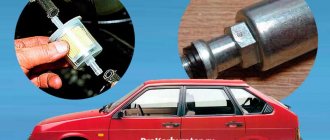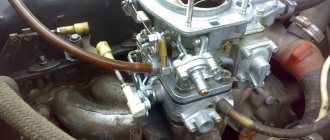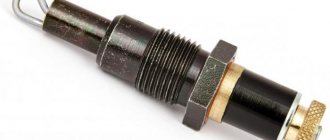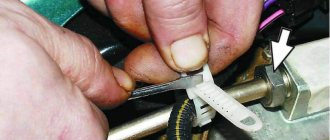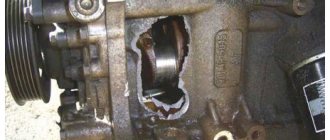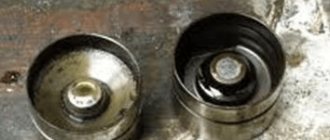List of reasons for stopping the carburetor engine of VAZ 2108, 2109, 21099, 2105, 2107 cars and their modifications while driving (on the move). This problem can arise due to malfunctions in various engine systems: fuel, ignition, etc.
List of main malfunctions that lead to a car engine stalling while driving
The gas tank has run out of fuel
In one case, the readings from the fuel level sensor may simply be incorrect (it has failed). In another case, even if the sensor shows that there is little fuel left in the tank, the fuel intake in such a situation draws water, dirt, sediment and deposits from the bottom of the gas tank. The engine will not work with such a mixture and will stall, even while driving, even at idle. It is recommended to periodically flush the gas tank and fuel lines as a preventive measure to avoid such a problem.
Gas tank
Broken or clogged fuel line
Loose metal and rubber fuel pipes can break and fray over time. This will cause the engine to leak or reduce fuel supply, causing it to stall while the vehicle is moving. To prevent the occurrence of such malfunctions, it is recommended to periodically visually inspect the fuel lines along their entire length. It is also worth focusing on the persistent smell of gasoline that arises in this case.
In addition, as described above, all kinds of dirt and water can be drawn into the fuel lines from the tank. During the cold season, the presence of water in the fuel lines can lead to freezing.
Fuel hoses, the breakage or damage of which are the most dangerous, since fuel can get into the hot manifold and lead to a fire, the condition of these hoses must be constantly monitored
Disconnecting the central high voltage wire (armored wire)
A poorly secured central high voltage wire from the ignition coil to the distributor cap can become disconnected (jump off) while the vehicle is moving, causing the spark to disappear and the engine to stop. In some cases, this situation is accompanied by a bang in the muffler. It is necessary to visually verify the integrity of the central wire and the tightness of its tips in the sockets of the coil and cover.
Central armored wire
Broken wire in the low voltage circuit
First of all, these are low voltage wires of the ignition system (going to the coil, distributor, other devices of the ignition system, plugs of the fuse mounting block). Secondly, it is a “mass” wire connecting the battery and the body (“ground”) of the car. Its break or loose connection will lead to the engine stopping while driving, with the simultaneous disappearance of light in the control instruments on the panel, failure of direction indicators, sound signals, etc. It is necessary to visually inspect the low voltage wires, find the loose ends, and restore the “mass” connection wires. To help, diagrams of the ignition system 2108, 2109, 21099 and 2105, 2107.
Violation of the ignition timing angle
Sudden destruction of the elements of the ignition distributor (breakage or jamming of the springs of the centrifugal regulator), loosening of the elements and their displacement. Loosening the fastening of the distributor itself will lead to a shift in the ignition timing in one direction or another and the engine stopping while driving. In such a situation, only a visual inspection of the distributor and troubleshooting followed by setting the ignition timing (2108, 2109, 21099 or 2105, 2107) will help.
Distributor of cars 2108, 2109, 21099
Breakdown of the capacitor to ground
Malfunction for VAZ 2105, 2107 cars with a contact ignition system. The capacitor on the distributor may suddenly fail, and the engine will stall while driving. This malfunction is accompanied by “shooting” at the muffler. The capacitor must be checked and replaced if faulty. As a temporary measure, it is recommended to disconnect its wire from the “K” terminal of the breaker and move on. You can also use an audio capacitor. We connect its wire to the “P” terminal of the ignition coil, and the housing to ground.
“Sucking” foreign air into the power system
In this case, the fuel mixture becomes very lean and the engine stalls. This can be caused by a poorly secured carburetor (air is sucked under its flange) or intake manifold. The malfunction is eliminated by tightening the carburetor and manifold mounting nuts or replacing the gaskets under them.
Places where foreign air can leak into the carburetor on VAZ 2108, 2109, 21099
The valve timing is out of whack
Perhaps a loose timing belt (on 2108, 2109, 21099) has jumped a tooth or two.
The cause of a stalled engine is the spark plugs
In 50% of cases, the problem is due to the fact that the spark plugs simply do not produce a spark. This failure occurs as a result of 3 reasons:
- contacts become clogged;
- plaque forms along the entire contour of the candle;
- malfunction when supplying voltage to the spark plug.
However, the most popular is still black carbon deposits on the spark plugs, which prevents the spark from appearing or causes it to work periodically.
Tip: if the spark plug set malfunctions, you will hear a “triple” sound that is uncharacteristic of the engine. In this case, the car will jerk strongly while moving. As a result, the engine will either stall on its own, or you will need to turn it off and turn the ignition on again.
If you see dirt on the surface of the contacts, this indicates the need to replace a low-quality type of fuel or check the serviceability of the oil supply systems. It is the oil supply adjustment sensors that can splash the spark plugs with it if there is a problem. Also, oil that appears on a set of spark plugs may indicate serious damage to components in the engine cylinders. Be sure to check the engine at a car service center. Otherwise, further operation may lead to expensive replacement of jet rods and even the entire set of pistons.
If you systematically use low-quality gasoline samples, you may find a red-brown coating on the contour of the spark plug. In this case, cleaning will not help - it is better to immediately replace the entire set after a new refill. If you find that the car periodically turns off at full speed, but starts easily even with clean spark plugs, then the problem lies in the electrical wiring.
Ways to prevent breakdown
To avoid this, it will help to completely flush the injector and diagnose your vehicle after 30 thousand kilometers. But it is necessary to take into account that the problem may be hidden simply in a malfunction of the sensor itself for measuring speed.
Everything here, of course, is very simple, you need to go to the store and buy it, it costs about 200 rubles and the process of replacing the sensor is not very difficult.
There are countless stories about the complete assembly and disassembly of the legendary “nine”, followed by the normal functioning of the unit, taking into account the remaining “extra” parts.
If it is not possible to fix the problem yourself, it is better to contact specialists, they will definitely help, do not forget that poor-quality car repairs can only lead to new, often more serious, breakdowns. And then you will definitely have to contact the service, paying much more money than you could have paid before. Take care of your lives and cars.
Source
The cause of a stalled engine is a power supply failure
In this type of problem, 3 reasons may be involved:
- Poor contact with the terminals of the new battery;
- Detection of poor contact or breakdown along the entire length of high-voltage wires;
- The appearance of malfunctions in the generator or ignition coil system of the car.
If the problem lies in damp high-voltage wires, then it is best to replace them completely along with the battery contacts. If the terminals make poor contact, you need to carefully clean them with sandpaper and try to reconnect them.
If the generator is found to be inoperable, the problem usually boils down to problems in the following parts:
- Broken timing belt;
- There is a malfunction inside the housing of the unit itself.
A problem with the generator is easily detected when the corresponding indicator on the dashboard turns on. In addition, if there is insufficient energy supply, the backlight of the on-board panel will gradually fade, and a set of other diagnostic sensors will show incorrect values.
Advice: if when you press the gas the car jerks, then stalls and cannot start, then the problem is related to the failure of the ignition coils. It is best to replace these parts in a car service using special equipment.
From the list of reasons that are directly related to the car engine, you need to move on to problems that arise in the fuel and air supply systems, as well as malfunctions of components responsible for exhaust gas removal.
Ignition coil
Engine operating principle
The VAZ 21099 is equipped with a carburetor and injection engine with distributed fuel injection. The engine volume is 1.5 liters. Each of the four cylinders has a separate injector that delivers fuel.
Using a neutralizer, the engine monitors the composition of the exhaust mixture and independently regulates it in order to create the most optimal mixture.
Several components are required for proper engine operation.
Neutralizer
Determines the composition of the mixture in the exhaust system to use fuel as efficiently as possible. Adjusts the fuel mixture when it detects unburned hydrocarbons and carbon monoxide. By adjusting the fuel mixture, harmless water vapor and carbon dioxide appear in the exhaust system.
ECU
It receives information from various sensors and issues commands to regulate the mixture. The ECU receives these parameters as information:
- internal combustion engine air consumption;
- position, as well as crankshaft speed;
- fuel supply;
- detonation;
- engine cooling system temperature;
- the speed at which the car is moving;
- battery voltage.
Memory device
It stores information about mixture ratios, operating algorithms, and also stores information about errors.
Only when all units are working properly will the engine function smoothly.
Fuel supply faults
It is quite easy to find out that the car stalls while driving due to the engine being “choked” with the fuel mixture - during a long drive you will find that the signal of the sensor responsible for this function is constantly on.
Here the problem lies in low-quality fuel, which does not quickly “ignite” from the spark of the candles. It can also be caused by gasoline not meeting the requirements for the octane number specified in the vehicle specifications. If there are problems with fuel, the gas pedal will be pressed all the way, and the car will not begin to gain speed. In addition, the car will periodically stall when the clutch is engaged.
Another symptom indicating problems with fuel is the appearance of problems with the car after refueling. The problem is characterized by a rapid drop in engine power at full speed, as well as when constantly changing gears. The way out of the situation is to completely drain the bad fuel mixture, wash the engine and all the fuel system pipes.
Also, the car will constantly stall if there is an interruption in the supply of the fuel mixture. This may be due to contamination in the following system components:
- Dirt in the fuel filter;
- Problems with injector nozzles;
- Dirty throttle valves;
- Fuel pump power failure.
The main symptom of a malfunction of these parts is that there will be a gradual drop in the power of the car’s engine, after which the car will stall even after sharply pressing the gas pedal. If you do not release the clutch carefully when changing gears, this will also cause the engine to stall.
The contamination of the fuel filter and fuel pump can be judged by the unstable operation of the machine even during idling and during rapid braking (when the supply of the fuel mixture decreases). And if the performance of fuel filters can be easily established during an external inspection and eliminated by replacing them, then to detect other causes, you need a full-fledged computer diagnostics, which can only be carried out in a car service center.
Another reason for a stalled car associated with the operation of the fuel pump is boiling gasoline in the fuel pump. This happens mainly in hot weather when the car is moving slowly or standing on the highway in traffic jams. The car will start to stall while driving, but when you turn on the idle speed and press the clutch, it will start again.
If boiling occurs, it is better to stand in a traffic jam with the engine turned off and gradually cool the car. After 5-10 minutes, the car's operation will be stable again.
Advice: if you recently did a wheel alignment with your own hands on a VAZ-2107, then to cool the car, proceed as follows - throw a piece of cloth made of dense material over the fuel pump body, which you first moisten with cold water.
When the engine warms up, the speed of the VAZ 21099 injector drops
- Registration
- Entrance
- To the beginning of the forum
- Forum Rules
- Old design
- FAQ
- Search
- Users
OZONE carburetor? Then this is his feature
This is always observed at near-zero temperatures.
And another question at what speed should it be warmed up?
Everyone has a different opinion.
And another question: at what speed should it be warmed up? Everyone has a different opinion.
I have the same garbage 2000 21074 carb 21073. It warms up, lowers it a little, then increases.
I have the same garbage 2000 21074 carb 21073. It warms up, lowers it a little, then increases.
started after rebuilding the carburetor (assembled one of the two), even when the exhaust stinks of gasoline, everything warms up
What if carb
not OZONE, but
Solex
and there is such crap, what could it be?
Now on topic and fact
practically: In the morning before starting, we prepare the possibility of adjusting the air damper limit screw. Many people have to remove the air filter housing, but it is still better to have a long, narrow screwdriver. Next, we start the engine and, at the ready, insert a screwdriver into the hole and, having “groped” for the slot of the adjusting screw, insert it into this slot. Now, as soon as the engine begins to lose speed as it warms up, by adjusting this screw (usually by unscrewing it) we obtain the desired maximum speed when warming up. That’s the whole “problem” of the heating mode in Ozone.
Thank you! Need to try
We can’t talk about icing - the problem is around “0” degrees.
Rezo wrote:
We can’t talk about icing - the problem is around “0” degrees.
Let me disagree, I won’t argue with ozone, but on bakers (Volga) icing begins when warming up already at +10 and strong humidity. The XX unit freezes.
Secondly, it can be cured by heating.
In the morning before starting, we prepare the possibility of adjusting the air damper limit screw. Many people have to remove the air filter housing, but it is still better to have a long, narrow screwdriver. Next, we start the engine and, at the ready, insert a screwdriver into the hole and, having “groped” for the slot of the adjusting screw, insert it into this slot. Now, as soon as the engine begins to lose speed as it warms up, by adjusting this screw (usually by unscrewing it) we obtain the desired maximum speed when warming up. That’s the whole “problem” of the heating mode in Ozone.
In the morning before starting, we prepare the possibility of adjusting the air damper limit screw. Many people have to remove the air filter housing, but it is still better to have a long, narrow screwdriver. Next, we start the engine and, at the ready, insert a screwdriver into the hole and, having “groped” for the slot of the adjusting screw, insert it into this slot. Now, as soon as the engine begins to lose speed as it warms up, by adjusting this screw (usually by unscrewing it) we obtain the desired maximum speed when warming up. That’s the whole “problem” of the heating mode in Ozone.
Now on topic and fact
practically: In the morning before starting, we prepare the possibility of adjusting the air damper limit screw. Many people have to remove the air filter housing, but it is still better to have a long, narrow screwdriver. Next, we start the engine and, at the ready, insert a screwdriver into the hole and, having “groped” for the slot of the adjusting screw, insert it into this slot. Now, as soon as the engine begins to lose speed as it warms up, by adjusting this screw (usually by unscrewing it) we obtain the desired maximum speed when warming up. That’s the whole “problem” of the heating mode in Ozone.
The speed drops sharply and IMHO it will not be possible to adjust normally because of this
By the way, I tried to pull out the choke completely at 90 degrees. — the revolutions increase to 2.5k, there are no dips, but if I understand correctly, when the engine is warm (with the engine adjusted normally) there should be them, the engine should stop, right?
By the way, I tried to pull out the choke completely at 90 degrees. — the revolutions increase to 2.5k, there are no dips, but if I understand correctly, when the engine is warm (with the engine adjusted normally) there should be them, the engine should stop, right?
I noticed an unpleasant effect: when you unscrew the external screw (the adjusting screw underneath), the speed drops sharply and IMHO it will not be possible to adjust normally because of this.
Where does this information come from? quote]
It was somewhere in this forum. I think Rezo mentioned something similar in one of the previous topics about warming up.
Malfunctions in the air mixture supply system
Here the problem lies either in a clogged air filter or in the failure of the regulator responsible for idling the car. In this case, your car will stall all the time when you gain speed or when you release the gas when you release the accelerator.
To solve the problem, remove and inspect the air filter. If there is serious contamination or chips, replace it. To diagnose and replace the idle speed regulator, you will need the help of qualified car service employees.
Types of input and output signals
The ECU processes only a few types of input signals:
- digital signal (has only two levels - “high” and “low”). This signal is also called logical, since it has only two values - true or false (true/false), logical 0 or logical 1;
- a pulse signal is a short-term change in a physical quantity. For example, based on the number of pulses from the ABS sensor, the control unit calculates the rotation speed of each wheel;
- analog signal – described by a function of time and a continuous set of possible values. In a car, these signals include voltage measurements.
Master cascades used to control actuators can generate a switching signal and a pulse-width modulated signal
A PWM signal is characterized by the duty cycle of the pulses - the ratio of the period of the pulses to their duration. The duty cycle is expressed as a percentage, which shows the ratio of the period of voltage supply to the period of de-energized state
For example, if the duty cycle of the idle air regulator (IAC) control signal is 50%, then the regulator rod will be extended halfway.
While pulse width modulation allows flexible control of the actuator, the switching signal has only two states - on or off. This signal will be the inclusion of a fan, air conditioner clutch, etc.
Car exhaust system problem
The engine may also stall if the tubes responsible for removing gases are malfunctioning. At full speed, the car will quickly begin to “choke”, and pressing the gas pedal completely stops the engine. Malfunctions in the operation of the exhaust pipe system in 90% of cases are caused by contamination and clogging of the muffler. However, the catalyst may also fail.
In the first case, carefully clean the muffler and remove foreign objects from there. If there are problems with the catalyst, conduct a complete diagnosis of the exhaust system and replace this element.
Idle Air Control Malfunction - Check Engine Signal
A dictionary of error codes is easy to find on the Internet.
Control systems in cars with an injector record deviations in the operation of the fuel regulator. Below are some possible IAC failure codes with decoding:
- P1509 (control circuit overload);
- P1513 (short to ground);
- P1514 (open circuit or other problems at 12 V).
If you receive information about a problem, check the wiring - perhaps the problem lies there. Test codes are received through a special connector using a scanner. You can decipher the obtained values yourself using special tables (search online). If you can't quickly check the system, a thorough cleaning will help delay replacement for some time.
You can determine the serviceability yourself, but this will require skills and an oscilloscope.
What to do if cars with automatic transmission stall?
If your vehicle has an automatic transmission, then the problem should be found in the electrical supply. If you abruptly switch from one gear to another, or while switching gears while braking, the settings may be distorted, and the on-board computer will receive a signal to turn off the engine.
Also, models with automatic transmission may stall due to malfunctions of the hydrodynamic transformers of the gearbox. This problem mainly manifests itself during acceleration and requires urgent intervention from car service specialists.
Conclusion
If the engine speed, on a VAZ 2109, 21099, with an injector power system, floats during idle, do not rush to change the IAC. The cause could also be a faulty TPS. On newer models - 2110, 2115, etc., if the TPS malfunctions, the “CHECK ENGINE” light comes on, which helps to determine its failure, since its symptoms, with IAC, are absolutely the same. Well, on models 2109 and 21099, a breakdown of the TPS is determined during an independent, separate check.
#1 Mity76
- Users
- 7 messages
- Car make: VAZ 21099i
- From: Yaroslavl
#2 Nighttrain
- Car make: 21130
- From: Russia
Post edited by Nighttrain: November 20, 2012 – 05:29
#3 99_style
- Car make: VAZ-21099 carb. (converted to engineer) =>VAZ-2112
- From: Yaroslavl
#4 Mity76
- Car make: VAZ 21099i
- From: Yaroslavl
take a tester and measure the voltage on the mass flow sensor, insert the tester into the sensor chips closest to the windshield and into the middle one, set the limit to 10V or 20V and turn on the ignition, see what the voltage shows, if the voltage is 0.97-1.04V, then it’s not the problem, if change it higher! when IAC changed the throttle and cleaned it, what was the mileage?
I haven’t cleaned the throttle for 60,000 miles and I can’t even imagine where to clean it and with what
Checking high voltage wires
When everything is in order with the ignition system, but the problem has not yet been solved, then the high-voltage wires are diagnosed. Under stable loads they can also fail.
As a rule, if the problem comes from the wiring, then the insulation or conductive parts in it are destroyed. Based on this, the electricity does not reach its destination and there is no spark. If the insulation is damaged, a breakdown occurs between the residential and vehicle ground. As a result, some of the electricity is lost, and this leads to a loss of spark power.
Checking the wires is carried out similarly to diagnosing spark plugs. Additionally, examine the wire resistance parameters. The range of acceptable values should be from 0.4 to 0.9 kOhm.
Diagnosis of IAC
How can you diagnose a faulty idle air control valve?:
- You stopped for 5 minutes after a long trip, naturally the engine is hot. After this, you try to start the engine, but the engine does not start or starts and immediately stalls. Even if the engine starts, the normal idle speed is not set immediately, but only after pressing the gas pedal more than once.
- The same situation can occur on a cold engine. The first time the engine starts and immediately stalls, but the second time it runs fine.
- Whatever the engine, hot or cold, it starts only when the gas pedal is depressed.
- The situation is the same as in point 3, but the accelerator pedal must be held constantly until the engine warms up or the car starts moving.
- You braked sharply and the car suddenly stalled; when you restart, the idle speed remains within normal limits.
- The idle speed hangs in an inflated range from 1500 to 2000 revolutions and only after revving it returns to normal values. Therefore, if your car’s engine starts and immediately stalls, try immediately flushing the throttle assembly and idle air control. If this doesn't help, just replace the IAC and that's it.
What does IAC look like?

